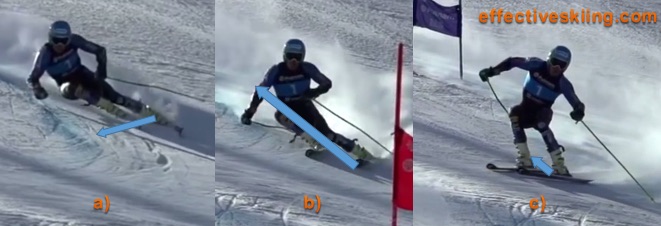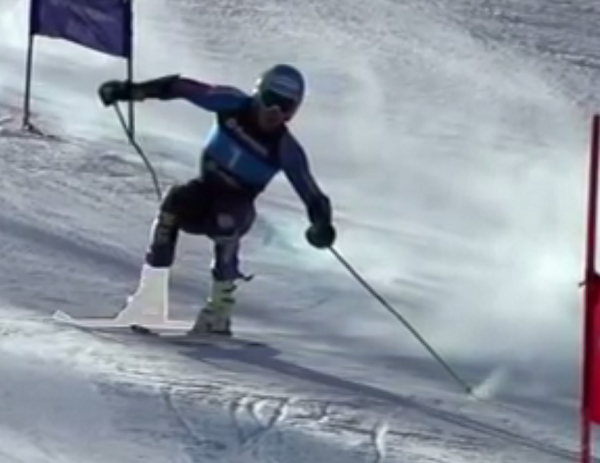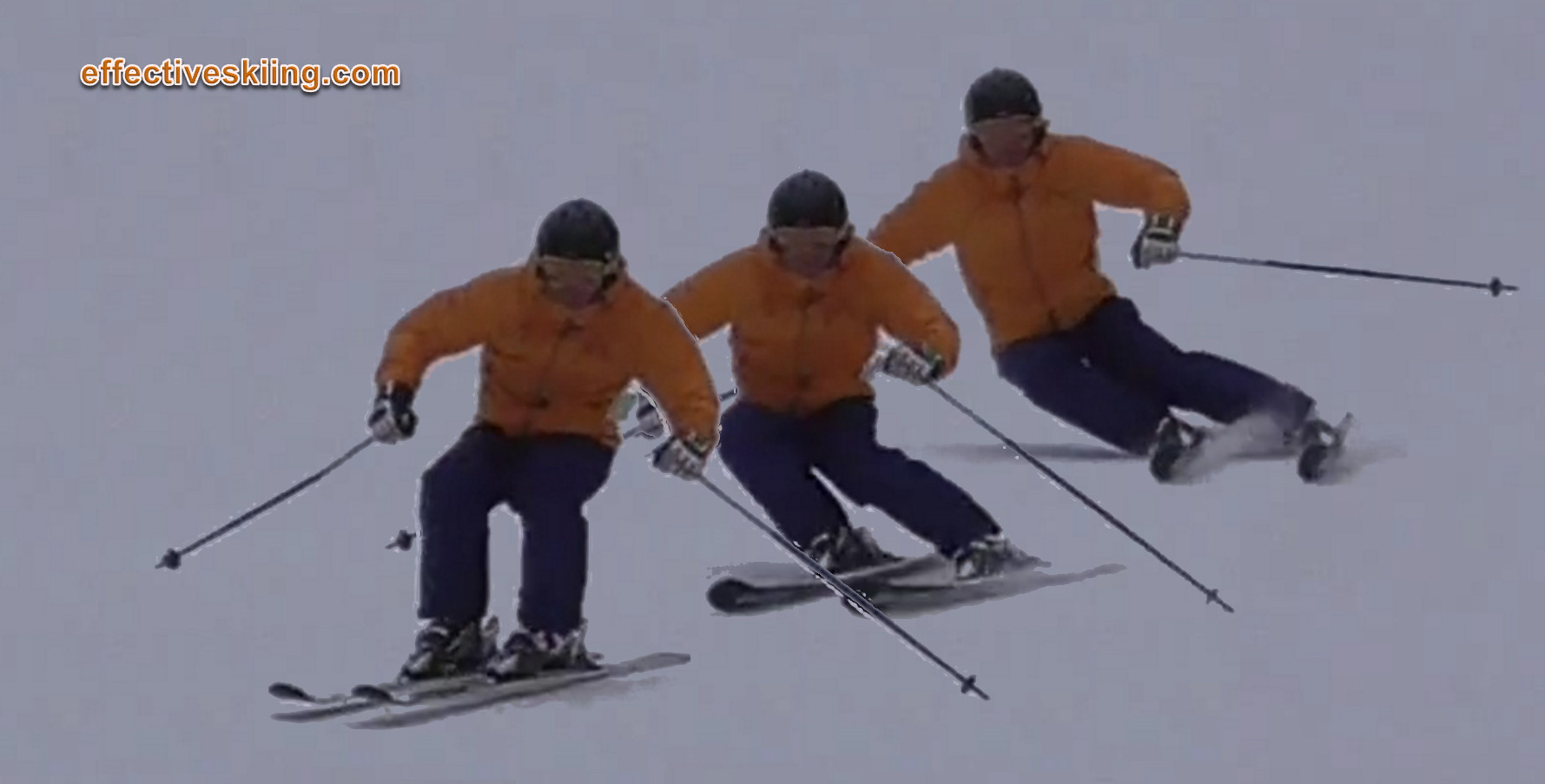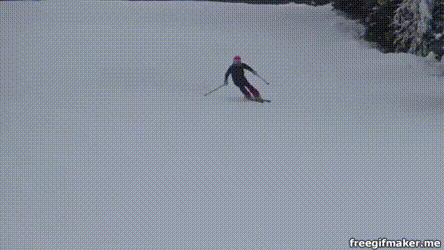Release
Pub
Share
The release and transfer are arguably the most important parts of the turn - as they will set up all the elements for the next turn as well. The purpose of the release is to end the previous turn by basically releasing the edges from the previous turn, whether carving or not.
In general, the release movements start with softening the outside leg, to remove weight from the outside ski and continuing with the ankles and the feet, to flatten the skis, then knees and hips and so on moving into the new turn, but sometimes the "COM is released first" i.e. the relaxation of muscles will "release" the upper body before the skis.
At the most basic level, edge release starts in the ankle and progressively moves up the skiers kinetic chain. USSA GS Technique and Tactics
There are a few ways to release the skis, which can be combined with the subtle ankle movements above:
- Flexed release
Created by relaxing and shortening the long outside leg. Also sometimes called "down-unweighting" as a category - we also call this simply "the release". There are a few variants, given how strong the flexing is or how the transfer is accomplished or the order of muscle activation:- Retraction release
It's an extreme case of the Flexed release, where the legs are strongly retracted. Common in bumps and high-performance skiing. - Flexed or floating release
Both skis are light in transition, the edges are switched as the skis are tipped. This is the typical application of the flexed release. - Early release or early transfer
A flexed release, when transferring weight/balance to the new ski, before it is on the new edges, so transferring to the little toe edge of the old inside ski before it is tipped to the new edge. Also called the one-footed release - Weighted release or late transfer
When transferring late to the other ski, still maintaining some weight on the outside ski during the transition.1 - COM release
Created when the muscle relaxation/use releases first the upper body while keeping the skis slightly engaged a little while longer. Very similar to the Weighted release.
- Retraction release
- Extension
Created by pushing into both or only the outside leg (extending or hinging over an already long outside leg) and hopping "up". Sometimes referred to as "up-unweighting" or "cross-over".
The extension is most frequently seen in recreational skiing while the others are typical for expert and high-performance skiing and racing.
The others are merely different tactical variations of the same release process, based on timing, intensity, what do we move/relax first etc. Some of the interesting variations, like the Weighted release have their own name and topics, since they have specific uses and practice is important.
The release continuum
There is a large spectrum of releasing, between extension, pushing, up and over and flexing, between pushing hard on the skis at the end of the turn to throw the body upwards, versus a complete flexing and retraction of the legs, to allow the body to "fall" downwards. Weight transfer could start late or early as well... so when characterizing a release, we will look for the dominant characteristic. Here is how the types of releases contrast or combine:
- release: extension or hop and over vs softening and flexing the leg vs outside retraction
- transfer: early vs floating vs weighted
Muscle use
Another way to look at this is how the muscles are being used:
- isometric contraction is when we use the muscles without changing their length - as in resisting the forces of the turn
- eccentric contraction is when the muscles elongate in response to an external force
- concentric contraction - this is the typical use of the muscles, where they shorten and create force via leverage
If we resist the forces of the turn with a longer outside leg, we use isometric and perhaps eccentric contractions.
From here, two options are available:
- relax and possibly retract, for a flexed release
- extend, with concentric contractions, for an "extend to release"
- which foot: both, outside, inside or none
Foot use
We can also look at the releases based on how many and which feet are involved. The PMTS system has a good way of cataloguing them:
- the "two footed release" - a regular flexed release, with both feet on snow
- the "one footed release" - the "early release" or "early transfer"
Energy and speed control
One of the important elements of a release is to extract energy from the turn - this is related to floating.
Some perceive the flexed release as wasting the energy of the turn. That is though one of its advantages and why it is used in performance skiing and high-level racing. In high-performance skiing, we generate a lot of energy, as you see in the frames above: even with the strong absorption and the boots still came off the snow.
The energy generated in a turn is in direct relationship to the edge angles at the apex and carving. The energy is highest in a pure carved turn on the ice at maximum edge angles and lower in skidded turns at low edge angles (the skidding dissipates energy as the snow can't "push back") on soft snow.
Extension releases are generally used in low-energy turns, skidded and pivoted and/or without much edge angles, where little energy is generated in the turn and the skier ads to it with pushing "up" to be able to disengage the ski.
It is a high-level skill to extract as much energy from the turn, in the desired direction, as needed but not more! This is generally what we refer to as getting Impulse.
The Speed control with retraction releases is a high-level skill (we cover that at the black levels). Easy speed control is why an extension with skidding is often used on steeper slopes.
What is a release?
Let's look at the release concept itself first. This skier needs to end the one turn and transition to the next. When should this skier do what?

See When to relax to release for a detailed discussion, but briefly:
- a) the skis are in the fall line, the outside leg is long and strong, the Ground Reaction Force (GRF) is pushing inside and maybe down a little
- b) the skis turn out of the fall line, across the direction of travel of the body. The GRF will increase and start pointing up.
If the skier did nothing in b) and kept that outside leg long and strong, think about a stick: the bottom of the stick keeps falling away down the slope while the top of the stick is moving at 90 km/h (or less, at recreational speeds) down the hill. The top of the stick will basically vault over the entire stick, basically above, the body will vault and be sent up and over the long outside leg.
This will result in the skis eventually disconnecting from the snow as they're dragged over by the "vaulting" hips. That's not a release! The release is a controlled dis-engagement of the skis, which requires some flexion throughout several joints, to be able to decouple the feet from the hips and allow the skier to unweight and flatten the skis while the hips move where they're meant to go.
COM Release
The COM release is sometimes seen in speed skiing. The basic idea is that the body is released before the skis, generally via relaxation of specific muscles. At the same time, the skis are rolled off the edge, but it may result in something resembling an A-frame around the transition.
Think about the skier above, again. If at b) he relaxed the core muscles but kept the leg engaged a bit longer, the upper body will start going over and down the hill before the ski was disengaged - you can see a small element of that in c) as the upper body seems to be already moving down the hill slightly ahead of the skis.
These are normal variations dictated by terrain, line and circumstances, to which the skier adapts to. Some are practiced during specific sessions or drils.
Extension, or hop and over
Related to up-unweighting, this is based on a push and/or an extension of the legs, especially the outside leg, which will tend to push the hips and body "up". This will afterwards take the weight off the skis and allow them to end the previous turn. Afterwards means when the pushing is completed, usually around skis flat.
This is very similar to the stick vaulting analogy above - instead of passively letting the hips be vaulted over a long outside leg, the skier even adds some to that process, by pushing the hips up!
It is an older technique, called "up-unweighting" and usually followed by a pivoting of the skis - while the skis are disconnected from the snow and any rotation efforts or momentums easily affect their rotation.
Typically, the skier, in this case, will flex the outside leg throughout the turn (giving into pressure) and then extend/hop at the end of the turn, to release the edges, hence the name "up-unweighting".
It is very common but less effective, as it usually leads to excessive up and down movements as well as a loss of control (while the hips are "flying" up and down, all you can do is wait for them to come down, to get the pressure back on the skis).
More biomechanical considerations
To see more on this topic, you need a membership. (Member)
More reading
See:
- The transitions of Giant Slalom
- Flex to release
- Flexing
- Engage and release
- Release untip to skis flat
- Low in transition
The Garlands is a good drill to work on release/engage. The power release is great to hone your flexing to release as well.
Articles:
- Anyone can be an expert skier 2, p79 1
- USSA GS Technique and Tactics
- Tom Gellie has a good presentation on releasing: flexing to release.
You need to log in to post a comment!


